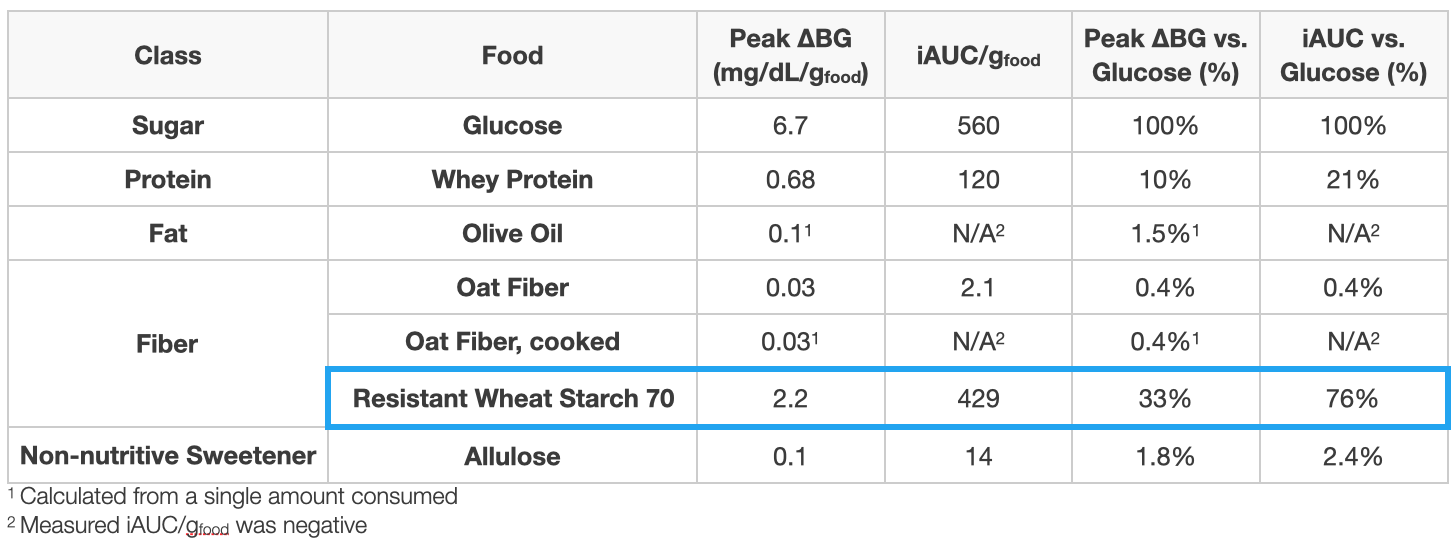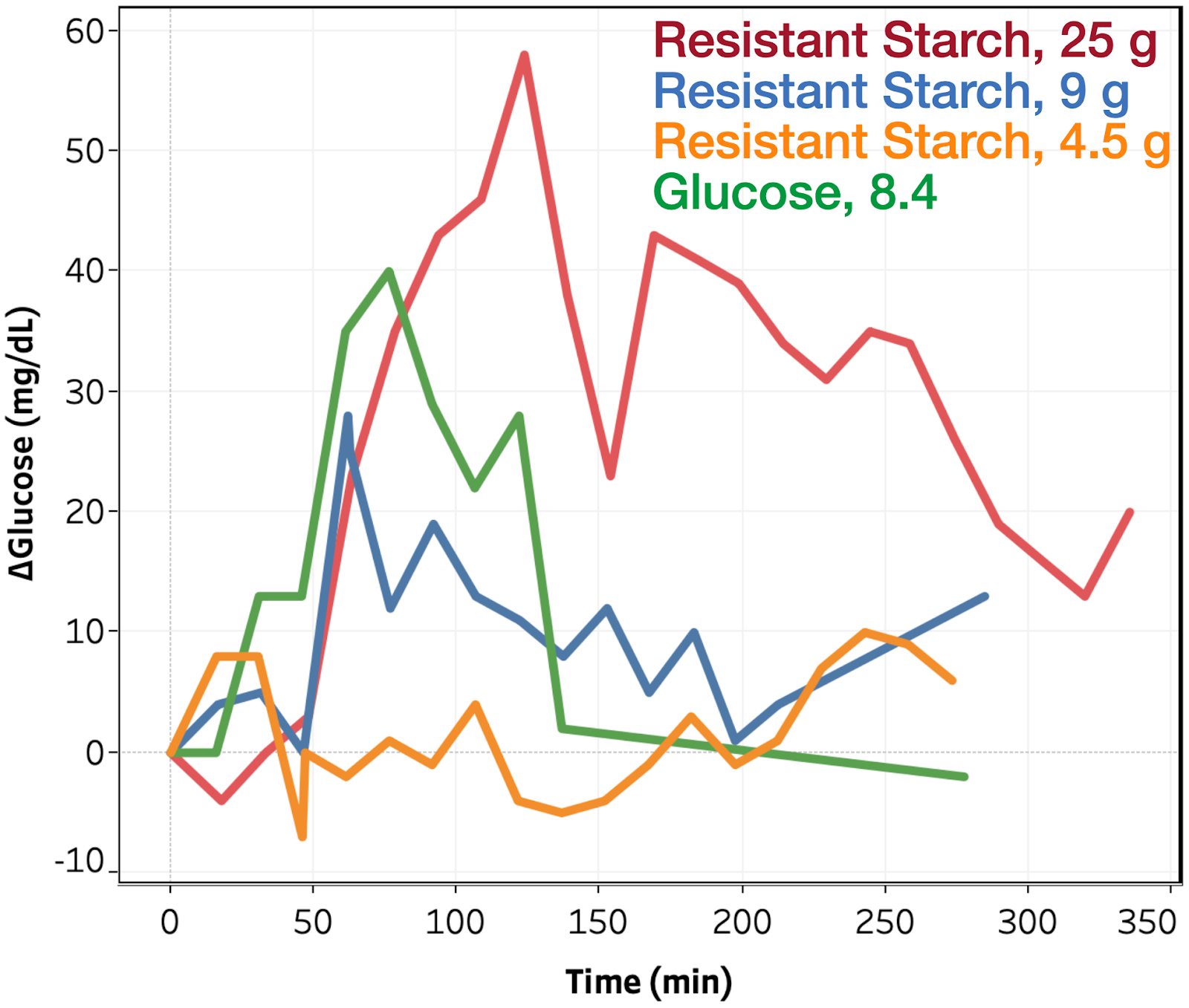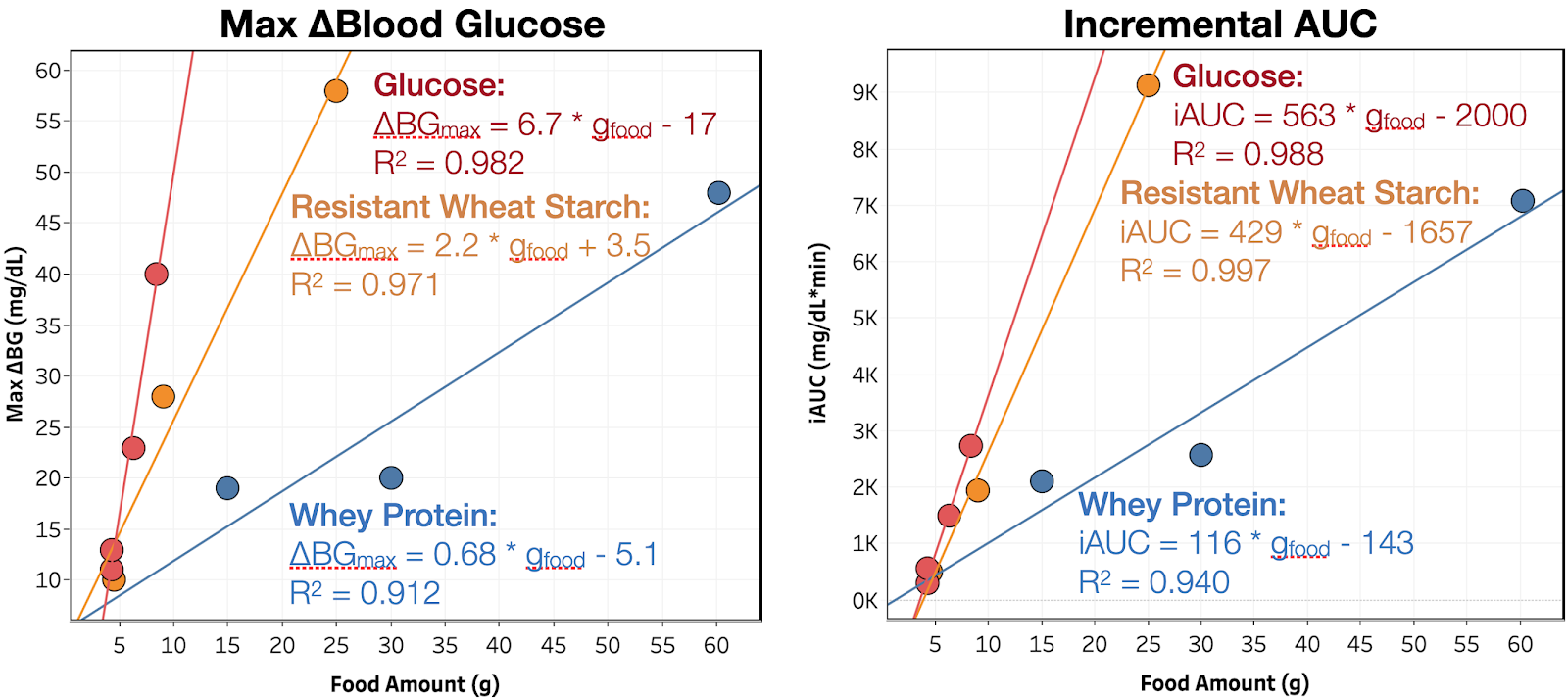Get new posts by email or rss feed
This self-experiment is being done as part of the Keating Memorial Self-Research Project. A couple of other people from the Open Humans community are also running the same experiments. If you’re interested in joining in, let me know in the comments or send me a PM.
This post is an update on my experiments measuring the effect of food ingredients on blood sugar.
Plan:
- Design experiments and solicit feedback: blog, Reddit, OpenHumans
- Calibrate continuous blood glucose meter: started 2/18, report tbd.
- Establish fasting baseline & determine time of day for experiments: Complete
- Food effect measurements
This week, I have the results from resistant wheat starch.
Summary
Resistant wheat starch, despite claims that it is not digested and doesn’t raise blood glucose, increases my blood sugar by 76% that of glucose (by iAUC), but with a slower rise, lower peak (33% that of glucose), and much longer tail.
This is especially problematic for predicting the blood glucose impact of foods from their nutrition information as based on my data so far, even insoluble fibers can range in impact from 0.4 – 76% of glucose.
Next week I’ll finish out the major macronutrient groups with cornstarch. Still deciding where to go after that, but it will either be more ingredients used in low carb cooking (inulin, erythritol, soluble corn fiber, lupin flour) or mixtures of the major macronutrients (to measure combinations effects.

Details
Purpose
To quantify the effect of ingestion of food ingredients and ingredient combinations on my blood sugar.
Ingredient Background
Resistant starch is starch that, purportedly, is not digested in the small intestine and therefore doesn’t increase blood sugar when consumed. There are four different classes of resistant starches, RS1-4, which differ based on how they’re formed and the method by which they resist digestion. Resistant wheat starch is RS4, meaning it was chemically modified to resist digestion in the small intestine.
Design/Methods
Procedure. From 7 pm the day before through 4:30p the day of experiment, no food or calorie-containing drinks were consumed and no exercise was performed. Non-calorie-containing drinks were consumed as desired (water, caffeine-free tea, and decaffeinated coffee). At ~12 pm, the substance to be tested was dissolved or suspended in 475 mL of water and ingested as rapidly as comfortable. BGM measurements were then taken approximately every 15 min. for 2 h or until blood glucose had returned to baseline, whichever was longer. A final BGM measurement was taken 4.5 h after ingestion.
Measurements. Blood glucose was measured using a FreeStyle Libre flash glucose monitor and a FreeStyle Freedom Lite glucose meter with FreeStyle lancets & test strips. No special precautions were taken to clean the lancing site before measurement. To take a sample, the lancing devices was used to pierce the skin at an ~45 deg. angle from the finger. Blood was then squeezed out by running the thumb and pointer finger of the opposite hand from the first knuckle to the lancing site of the finger. Blood was then wicked into a test strip that had been inserted into the meter and the glucose reading was recorded.
Data Processing & Visualization. iAUC was calculated using the trapezoid method (see data spreadsheet for details). Data was visualized using Tableau.
Medication. I took my normal morning and evening medication, but did not dose for the experimental food ingested.
Data
Results & Discussion


Changes in blood glucose as a function of time for the resistant wheat starch and glucose tests are shown in Figure 1. For resistant wheat starch, I observe an increase in blood glucose starting at ~45 min. and reaching a peak between 75-120 min. While the timing is similar to that of whey protein, the magnitude of impact is much larger, with the peak change in blood glucose and iAUC increasing by 33% and 76% vs. glucose. It will be interesting to see next week how regular corn starch compares to resistant wheat starch and therefore if the chemical modifications to resist digestion are having any meaningful impact.
Conclusion & Next Experiments
Resistant wheat starch, despite claims that it is not digested and doesn’t raise blood glucose, increases my blood sugar by 76% that of glucose (by iAUC), but with a slower rise, lower peak (33% that of glucose), and much longer tail.
Put together, this indicates that resistant wheat starch is slower to digest than glucose, but contrary to the claims above, is clearly still metabolized to glucose. This is extremely disconcerting, as both oat fiber (iAUC 0.4% of glucose) and resistant wheat starch (iAUC 75% of glucose) are listed as insoluble fiber on nutrition labels, but have radically different impact on blood sugar. Given the lack of clarity and quantification of ingredient lists, this makes it nearly impossible to predict the blood glucose impact of a food without eating it and testing.
Next week I’ll finish out the major macronutrient groups with cornstarch. Still deciding where to go after that, but it will either be more ingredients used in low carb cooking (inulin, erythritol, soluble corn fiber, lupin flour) or mixtures of the major macronutrients (to measure combinations effects.
– QD
Thank you. I have been eating a "keto" bread for months now whose first ingredient is resistant wheat starch, and I've been wondering why I'm not losing weight. Pretty sure this must be why.
Very interesting. Which brand have you been eating? I started a new food study last week where I'm measuring the blood glucose impact of different "keto" prepared foods and seeing how it correlates with the listed ingredients & macros.
First post will be next weekend, on tortillas (sneak peak: La Tortilla Factory has about half the BG impact compared with all the other tortillas I tried). I just tested my first bread (Costco Franz Keto White Bread) yesterday and the BG impact was pretty substantial (Max BG 25% of glucose & 5h area under the curve 55% of glucose). Definitely going on my don't eat list.
Hi, I have been eating Lewis Keto bread. It's on the shelf at my local Walmart. I honestly feel that it is dishonest labeling. All the info on the internet is that resistant starches pass through undigested. I am thinking this is not true. When I ate low carb without keto breads and cereals the weight flew off me. Since I added Lewis Keto bread and Carbquik I have GAINED so much weight and even after tracking calories at 1200 a day I am not losing weight. I have been eating at least 2 slices a day for at least 6 months. I was so happy to eat bread and now I think I have to quit it entirely
Must be the carbquik, I eat the same bread and I have lost weight and it stopped the symptons of Diverticulitis.
I’ve been doing Keto and using the Lewis Keto bread regularly. I have lost weight, but strange glucose results. When I have Lewis Keto bread with tuna salad, it produces a small glucose spike, but when I have it with grilled cheese (with no carb butter and cheese), it spiked my glucose on my CGM. Disconcerting.
Yeah… The problem is that the labeling rules specify that all fiber should be grouped under "dietary fiber" even though the effect on blood sugar varies tremendously. To give the regulators the benefit of the doubt, I suspect the rules were created before the that was known or at least known to be important. For me, if I want to find a truly low carb food, I have to first look for low net carbs, then throw out anything that has a fiber or sugar alcohol that actually affects blood sugar (malitol, xylitol, resistant wheat starch, etc). Even then, I frequently get fooled by a label by either missing something on the label or not catching it due to a different name.
Drives me nuts…
Some people on YouTube have tried these "zero net carb" breads and do blood testing and it doesn't affect their blood sugar at all. I don't know what to believe, I think it's time I did my own testing (I don't have a monitor.) I will sure miss this bread though if I have to quit it which I probably will.
I've got diabetes and produce almost no insulin on my own, so my blood sugar is much more sensitive to carbs than most people, even most non-type 1 diabetics. I would be surprised if someone with normal metabolism would see a blood sugar rise unless they ate a lot of the zero-carb bread, but it's still being metabolize and inducing insulin production for them.
That said, without more people replicating these results, we don't know how much they vary from person to person, so definitely worth doing your own testing. Just make sure you baseline against a known quantity of a regular carb (glucose, starch, etc.) so you can compare.
Forgot to mention, I'm doing testing of a bunch of low-carb foods right now. Tortillas were posted last week. I'll be posting cereals on Saturday and breads in a few more weeks.
Oh that's interesting, I wonder about Magic Spoon cereal myself. It's really good
Post just went live a few minutes ago. Magic Spoon was my favorite of the non- granolas and was pretty decent on BG impact.
Can you please test the Hero brand bread? This is the one being sold to Subway and claims 0 net carbs.
Interesting. I love Subway salads but haven’t tried the new low-carb bread. It’s main ingredient is resistant starch, so I’m not optimistic, but worth a shot. I switched over to a pump, so will need to re-measure my baseline BG before I can do more food effect measurements, but I’ll give it a shot.
I just tried L’oven Fresh Keto bread (I ate 2 entire bags at once, believing all the net carbs was fiber carbs) and fuck, 2 hours later when I finally decide to test my CGM on it, my glucose was 196. Fuck. Fuck.
Yeah, that another one that uses resistant wheat starch. Really bugs me that that can be listed as a fiber…
please test Hero brand white bread and the wraps. they are delicious but I suspect they are not really zero impact. it’s quite expensive and its made its way into our kitchen and I am noticing reduced weight loss and regular constipation.
Looks like they’re made with resistant wheat starch. Virtually everything I’ve tried with that had a huge blood sugar impact, with the exception of Carbonaught. I’d be very surprised if it was zero impact.
Resistant starch as formed naturally (as in cooked-then-cooled potatoes or rice, for example) converts mostly back into regular starch by reheating. I’m wondering if, in YOUR tests, you have heated the tortillas?
(most people DO heat these various “engineered low-carb” products –some brands even publish recipes for cooking with them– but in my research that changes their chemical structure completely! Quite deceptive of them to not warn of these effects if they are indeed true.)
For all of my tests, I ate the tortillas plain and uncooked, so that wouldn’t have been a factor in my results. Would be interesting to test whether the commercial resistant starches become less resistant with heating.